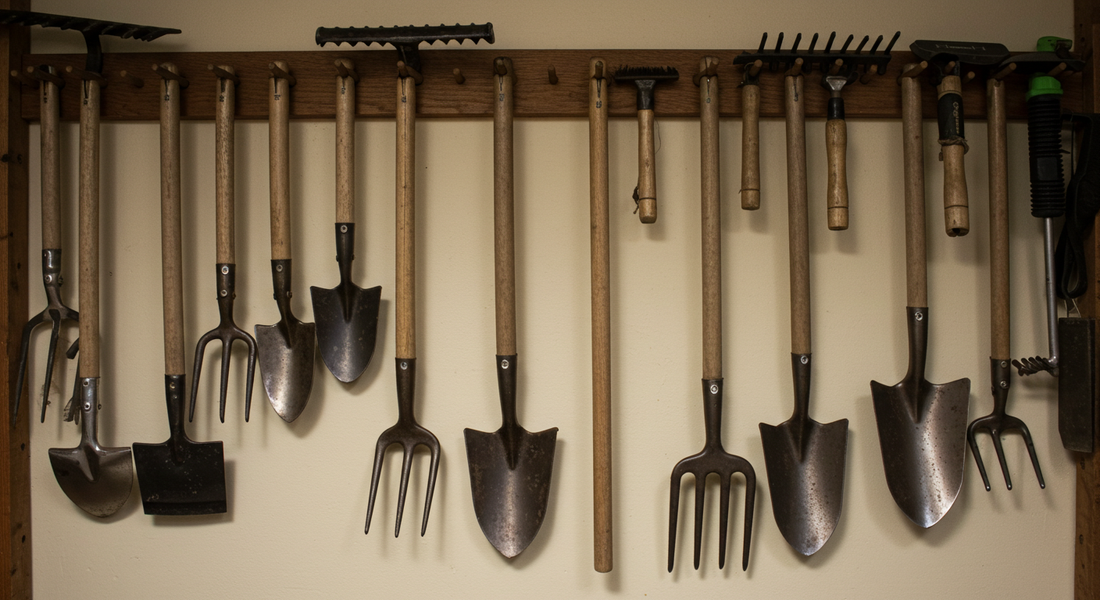
How to Clean, Sharpen, and Store Your Garden Tools to Make Them Last a Lifetime
Share

Good garden tools are an investment. A quality shovel, a sturdy pair of pruners, or a reliable hoe can be your trusted companion for years, but only if you protect that investment. Regular tool maintenance is one of the most overlooked but impactful tasks in any gardener's routine.
The benefits are huge: clean tools prevent the spread of plant diseases, sharp tools make your work easier and safer, and properly stored tools will last a lifetime. This guide will walk you through the essential tool maintenance tips to keep your gear in peak condition.
The Cleaning Process
This is the first and most frequent step. A quick clean after each use can prevent a world of problems down the line.
-
Routine Cleaning: After a day in the garden, use a stiff brush and a putty knife to scrape off any caked-on mud and debris. For tools that have been used on sappy plants, a rag with a bit of turpentine can easily remove sticky residue.
-
Deep Cleaning and Disinfecting: At least a few times a season, give your tools a deep clean. Wash them with soap and water, then dry them thoroughly. To prevent the spread of fungal and bacterial diseases from one plant to another, it's crucial to disinfect your cutting tools (like pruners and loppers). A simple solution of one part bleach to nine parts water, or a wipe-down with rubbing alcohol, is highly effective.
The Sharpening Process
Dull tools are dangerous and inefficient. A dull shovel requires more force, increasing strain on your body, while dull pruners crush plant stems instead of making a clean cut, leaving them vulnerable to disease.
-
Why Sharp Tools are Better: A sharp blade slices through soil and branches with ease, requiring less effort and reducing the risk of injury. It also makes for healthier plants by creating clean cuts that heal quickly.
-
How to Sharpen with a Mill File: Sharpening garden tools is easier than you think.
-
Secure the Tool: Place your shovel, hoe, or other digging tool securely in a vise or clamp it to a workbench with the cutting edge facing up.
-
Find the Bevel: Look closely at the edge of the blade. You will see a factory-ground angle, or "bevel." Your goal is to follow this existing angle.
-
File the Edge: Take a 10-inch mill file. Pushing in one direction—away from you—file the edge of the blade, maintaining the original angle. Lift the file off the blade on the return stroke. A few firm, even strokes are all it usually takes. The metal will become shiny and a small burr will form on the opposite side.
-
Remove the Burr: Lightly run the file flat along the back of the blade to remove the burr, leaving you with a clean, sharp edge.
-
The Protection Process
Once your tools are clean and sharp, the final step is to protect them from the elements, primarily rust.
-
Preventing Rust: Apply a light coat of multi-purpose or boiled linseed oil to all metal surfaces. This creates a barrier that repels moisture. An easy way to do this is to fill a bucket with sand and mix in some oil. Plunging your tools into the sand bucket a few times after use will both clean and oil them simultaneously.
-
Caring for Wooden Handles: Prevent splinters and cracks by periodically sanding any rough spots on wooden handles with medium-grit sandpaper. Afterwards, rub the handle down with boiled linseed oil to condition the wood and repel water.
The Storage Process
Proper garden tool storage is crucial, especially over the long winter months.
-
Best Practices: The ideal storage location is dry and protected from the elements, like a garage or shed. Never leave tools outside in the rain or lying on the damp ground.
-
Storage Solutions: There are many great DIY and commercial options. A simple pegboard allows you to hang many tools in a small space. You can build a simple and effective rack by cutting notches into a 2x4 mounted on the wall. Commercial wall-mounted racks with hooks and clips are also excellent for keeping your tools organized and off the floor.
Conclusion: A Little Care Goes a Long Way
Your garden tools work hard for you, and a little care goes a long way in return. By making these simple cleaning, sharpening, and storage practices a regular habit, you'll not only make your gardening tasks more enjoyable but also ensure that your trusted tools will be ready for a lifetime of service.
